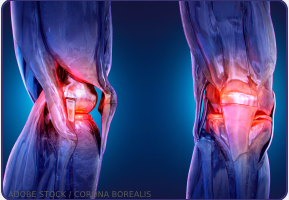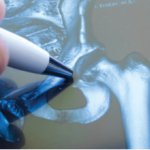 Working in conjunction with the American Association of Hip and Knee Surgeons (AAHKS), the ACR recently released a guideline on the optimal timing of elective hip or knee arthroplasty for patients with moderate to severe osteoarthritis or osteonecrosis who have already tried nonoperative interventions, without sufficient improvement. The guideline emphasizes the importance of shared decision making, incorporating individual patient needs, circumstances and preferences. It also conditionally recommends that joint replacement not be unnecessarily delayed by the requirement of additional nonoperative interventions.1
Working in conjunction with the American Association of Hip and Knee Surgeons (AAHKS), the ACR recently released a guideline on the optimal timing of elective hip or knee arthroplasty for patients with moderate to severe osteoarthritis or osteonecrosis who have already tried nonoperative interventions, without sufficient improvement. The guideline emphasizes the importance of shared decision making, incorporating individual patient needs, circumstances and preferences. It also conditionally recommends that joint replacement not be unnecessarily delayed by the requirement of additional nonoperative interventions.1
Guideline Backdrop

Dr. Hannon
One of the co-principal guideline investigators is Charles P. Hannon, MD, MBA, senior associate consultant in the Department of Orthopedic Surgery at Mayo Clinic, Rochester, Minn. He says that third-party payers often dictate whether patients are approved for arthroplasty, even when patients with severe disease have tried multiple nonoperative therapies without an acceptable improvement in pain, function and quality of life.
Even if the clinician and patient have collaboratively decided that arthroplasty is the best next step, a third-party payer may require a delay or an additional intervention, such as physical therapy, a different kind of physical therapy, another non-steroidal anti-inflammatory drug (NSAID) or joint injections. Other times, insurers may deny coverage for the procedure altogether unless certain criteria are met, such as a specific body mass index (BMI).
Susan M. Goodman, MD, professor of clinical medicine at Weill Cornell Medicine, an attending rheumatologist at the Hospital for Special Surgery, New York City, and co-principal investigator of the guideline, says, “Patients are facing unprecedented obstacles constructed by third-party payers preventing medically or surgically appropriate treatment. These have led to delays in treatment, as well as prolonged and unnecessary pain and loss of function. The abuse of pre-authorization has exploded, creating logjams in timely treatment.”
Jasvinder A. Singh, MD, MPH, professor of medicine and epidemiology at the University of Alabama at Birmingham, a staff rheumatologist at the Birmingham Veterans Affairs Medical Center and co-principal investigator of the guideline, adds, “Unnecessary delays result in patient suffering, poor quality of life, disability, decreased productivity at home or work, and potentially isolation and depression.”
Several writers of the guideline had previously assessed policies from several major payers. They found that payer policies used to deny or delay arthroplasty often cited medical literature that applied primarily to early-stage degenerative joint disease, studies that had limited or no applicability to patients with severe disease who have previously tried nonoperative approaches.
“It’s frustrating for both the patient and physician to delay surgery, but we didn’t really know whether the data showed if the delay made a difference,” says Dr. Hannon. “So one purpose of the guideline was to determine the effectiveness of delaying surgery for additional nonoperative treatments in patients who elected to proceed with surgery using shared decision making with their physician.”
Guideline writers also wanted to explore the value of potentially delaying surgery to modify risk factors for poor outcomes, such as high BMI, poor glycemic control in diabetes and nicotine use.
The current guideline recommendations apply specifically to patients with radiographically verified moderate to severe osteoarthritis of the hip or knee or, less commonly, with advanced symptomatic osteonecrosis (e.g., secondary to inflammatory arthritis). These patients have moderate to severe pain or loss of function and have previously attempted a form of nonoperative treatment.1

Dr. Goodman
Dr. Goodman adds, “All these patients have tried at least one modality [such as physical therapy, NSAIDs or intraarticular injections] and have either failed to benefit or have lost benefit from these other nonsurgical interventions.” Clinicians have assessed these patients’ comorbidities and prior nonoperative treatments, and they are indicated for total joint arthroplasty.
Thus, this guideline on surgical timing complements existing the 2019 ACR guideline on osteoarthritis that focuses on management strategies for osteoarthritis of the hand, knee or hip of varying severity, which may include such modalities as weight loss, physical therapy and NSAID use.2
After a systematic literature review and a rating of evidence quality, a Voting Panel discussed the evidence for PICO questions (i.e., population, intervention, comparator, outcomes questions) and voted for or against specific recommendations. The panel achieved high consensus for most of the recommendations, all of which members categorized as conditional, partly due to the relatively low quality of evidence available for this specific population. For the additional context and extended discussion of the full recommendations, see the full guideline.
“This guideline should serve as a starting point for discussions between patients and physicians, so that the patient can participate in a shared decision-making process,” says Dr. Goodman.
Third-party payers often dictate whether patients are approved for arthroplasty, even when patients with severe disease have tried multiple nonoperative therapies without an acceptable improvement in pain, function & quality of life.
Delaying for Additional Interventions
Conditional recommendations: Proceed to arthroplasty instead of delaying arthroplasty three months. Proceed to arthroplasty over delaying arthroplasty for a trial of physical therapy, braces or ambulatory aids, NSAIDs, intra-articular glucocorticoid injections or viscosupplementation injections.
Dr. Hannon explains that payers often require roughly a three-month delay before approving insurance coverage for arthroplasty, but in the literature review, the guideline authors found no evidence of any benefit for such delays. However, some patients may still opt to delay due to personal, work or family reasons, or to achieve better management of other medical comorbidities.
“For patients who’d been indicated for surgery, we found that making them do another injection, for example, or have more physical therapy sessions, or NSAIDs, gave no additional effectiveness,” says Dr. Hannon. However, in some circumstances, delaying surgery to pursue one or more options may still be the right choice (e.g., delaying surgery for physical therapy in a patient actively recovering from a stroke).
Payers may be opting to postpone arthroplasty for cost considerations. However, Dr. Hannon notes that ultimately such delays may increase total cost on the healthcare system because patients may use interim treatments that would not be needed if arthroplasty were not delayed.
Although surgery always carries risks, unnecessary surgical delays also pose risks, such as the risk of acute kidney injury or cardiovascular effects in patients taking NSAIDs.
Delaying for Modifiable Risk Factors
Conditional recommendations: In patients with a BMI of 35 or higher, do not delay arthroplasty for weight reduction.
Scientists have found correlations between greater BMI and poorer arthroplasty outcomes, particularly with respect to post-surgical infection. Dr. Hannon points out. Although “studies haven’t directly proven that a high BMI is what causes infection, [a] high BMI seems to result in an impaired immune response and decreased ability to fight off infection after surgery,” he says.
Thus, some payers have used weight loss as a criterion for surgical approval of arthroplasty. However, the available literature did not clearly indicate that holding off on arthroplasty for weight loss improved outcomes.
The guideline authors separately evaluated the research literature for three different categories of BMI—35 to 39; 40 to 49; and 50 and above—but did not recommend delaying for any of these subgroups.
Clinicians should educate their patients about increased risks from obesity and encourage them to lose weight if possible, and they should support patients who do opt to postpone surgery to focus on weight loss. However, many patients do not have the medical, financial, personal or social resources to lose much weight prior to surgery.
Dr. Singh notes that many patients have significant disease comorbidities and bilateral joint disease that may severely limit their mobility, also making it harder for them to lose weight.

Dr. Singh
Dr. Singh also points out that with newer medications for weight loss now becoming available to more patients, this recommendation may be updated in future guidelines, if the evidence supports that.
Conditional recommendations: In patients with poor glycemic control of diabetes mellitus, consider delaying arthroplasty to improve glycemic control. In patients with nicotine dependence, consider delaying arthroplasty for nicotine cessation or reduction.
The link between diabetes and poor wound healing is well established, and patients with poor glycemic control have a higher risk of poor outcomes after arthroplasty. The guideline authors found a likely benefit of delaying arthroplasty to improve glycemic control. However, they were careful to recommend overall improvement, not achievement of a specific threshold.
On a similar note, Dr. Hannon says, “Decreased angiogenesis and decreased blood flow to the skin in active smokers leads to increased risk of wound complications and possibly infection.” The literature review found that delaying surgery while patients eliminate or reduce their nicotine use may benefit patients overall.
For this and other potentially modifiable risk factors, clinicians should educate patients about these risks and provide appropriate support (e.g., nicotine reduction strategies). “It is worthwhile to take more of a collaborative approach with these risk modifications, also working with the patient’s primary care provider,” says Dr. Hannon.
However, nicotine cessation or glycemic thresholds should not be absolute criteria for moving forward with arthroplasty. Dr. Singh says, “Many people face a lot of challenges in trying to combat [nicotine dependence, obesity and diabetes] and find solutions. They have a lot of coexisting medical problems, a lot of pain and emotional issues.”
An equity aspect applies to these discussions as well. Dr. Hannon notes that payers sometimes cite clinical guidelines in their policies as a justification to deny surgical approvals, but the authors don’t want these guidelines to reduce potential patient access.
Dr. Goodman points out, “Patients [who are Black] are more likely to smoke, have high BMI and have diabetes, so exclusionary criteria using weight, smoking and blood sugar would likely exacerbate the existing racial disparities in access to arthroplasty.”
Data from the 1999–2014 National Health and Nutrition Examination Survey (NHANES) demonstrated that fewer Black patients and fewer patients from households with lower incomes would be eligible for arthroplasty if rigid criteria were applied, including a BMI of <40, an HbA1c level of <8% or complete nicotine cessation. “We feel that discussing the specific risks that apply in a specific setting with our patients is a more appropriate and helpful approach than using absolute and rigid exclusions,” says Dr. Goodman.
Another reason not to have rigid cutoffs is that third-party payers may use such values in isolation to justify surgical denials, not considering the full clinical picture, Dr. Hannon notes.
“Someone with a BMI of 43 who is otherwise very healthy is very different from the active smoker with type 2 diabetes and a BMI of 45 and an active cardiac history—your willingness to move ahead with surgery is completely different,” says Dr. Hannon.
Emphasis on Shared Decision Making
The importance of shared decision making is a key theme in the guideline, and it was particularly important to the Patient Panel members who contributed their perspectives to the guideline Voting Panel. Members of the Patient Panel stressed the importance of the shared decision-making process in deciding to pursue arthroplasty, considering patients’ unique goals, preferences, risk tolerance, social support, socioeconomic status, medical and psychiatric comorbidities and disease severity.
“The patient and their physician should determine whether and when to proceed with arthroplasty together, after a discussion of the unique risks and benefits of the procedure for the individual patient,” says Dr. Goodman.
Dr. Hannon encourages rheumatologists to reach out early to orthopedic surgeons for their perspective through formal or informal consults, even if it’s not yet clear that a patient is a good candidate for arthroplasty. “I think a lot of us definitely appreciate those collaborations,” he says.
Ruth Jessen Hickman, MD, is a graduate of the Indiana University School of Medicine. She is a freelance medical and science writer living in Bloomington, Ind.
References
- Hannon CP, Goodman SM, Austin MS, et al. 2023 American College of Rheumatology and American Association of Hip and Knee Surgeons clinical practice guideline for the optimal timing of elective hip or knee arthroplasty for patients with symptomatic moderate-to-severe osteoarthritis or advanced sym. Arthritis Rheumatol. 2023 Nov;75(11):1877–1888.
- Kolasinski SL, Neogi T, Hochberg MC, et al. 2019 American College of Rheumatology/Arthritis Foundation guideline for the management of osteoarthritis of the hand, hip, and knee. Arthritis Care Res (Hoboken). 2020 Feb;72(2):149–162.

